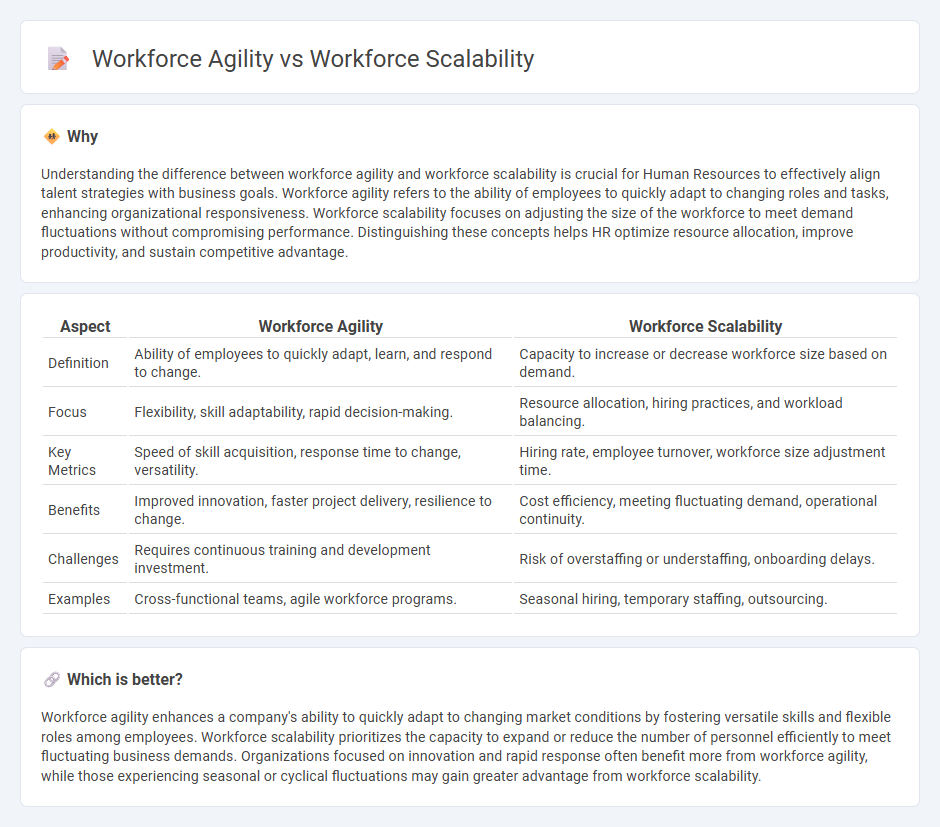
Workforce agility refers to the ability of employees to quickly adapt to changing business demands, while workforce scalability focuses on efficiently increasing or decreasing staff size to meet organizational needs. Agile workforces enhance innovation and responsiveness, whereas scalable workforces optimize resource allocation and cost management. Discover how balancing workforce agility and scalability can drive competitive advantage in today's dynamic market.
Why it is important
Understanding the difference between workforce agility and workforce scalability is crucial for Human Resources to effectively align talent strategies with business goals. Workforce agility refers to the ability of employees to quickly adapt to changing roles and tasks, enhancing organizational responsiveness. Workforce scalability focuses on adjusting the size of the workforce to meet demand fluctuations without compromising performance. Distinguishing these concepts helps HR optimize resource allocation, improve productivity, and sustain competitive advantage.
Comparison Table
| Aspect | Workforce Agility | Workforce Scalability |
|---|---|---|
| Definition | Ability of employees to quickly adapt, learn, and respond to change. | Capacity to increase or decrease workforce size based on demand. |
| Focus | Flexibility, skill adaptability, rapid decision-making. | Resource allocation, hiring practices, and workload balancing. |
| Key Metrics | Speed of skill acquisition, response time to change, versatility. | Hiring rate, employee turnover, workforce size adjustment time. |
| Benefits | Improved innovation, faster project delivery, resilience to change. | Cost efficiency, meeting fluctuating demand, operational continuity. |
| Challenges | Requires continuous training and development investment. | Risk of overstaffing or understaffing, onboarding delays. |
| Examples | Cross-functional teams, agile workforce programs. | Seasonal hiring, temporary staffing, outsourcing. |
Which is better?
Workforce agility enhances a company's ability to quickly adapt to changing market conditions by fostering versatile skills and flexible roles among employees. Workforce scalability prioritizes the capacity to expand or reduce the number of personnel efficiently to meet fluctuating business demands. Organizations focused on innovation and rapid response often benefit more from workforce agility, while those experiencing seasonal or cyclical fluctuations may gain greater advantage from workforce scalability.
Connection
Workforce agility and workforce scalability are connected through their shared focus on adapting human resources to changing business demands efficiently. Workforce agility involves employees' ability to rapidly acquire new skills and switch roles, while workforce scalability ensures the organization can increase or decrease staff size seamlessly. Together, they enable businesses to maintain operational flexibility and responsiveness amid dynamic market conditions.
Key Terms
Flexibility
Workforce scalability emphasizes the ability to increase or decrease the number of employees in response to demand fluctuations, ensuring operational efficiency and cost control. Workforce agility prioritizes flexibility in employee skills, roles, and processes to quickly adapt to changing market conditions and innovate effectively. Discover how balancing these strategies can optimize your organization's flexibility and competitiveness.
Adaptability
Workforce scalability measures a company's ability to increase or decrease its labor force in response to demand fluctuations, prioritizing size and capacity. Workforce agility emphasizes adaptability, enabling employees to quickly shift roles, skills, and processes to meet evolving business challenges. Explore how adaptability enhances competitive advantage by driving agile workforce strategies.
Resource allocation
Workforce scalability emphasizes the ability to increase or decrease employee numbers quickly to meet fluctuating demand, optimizing resource allocation by balancing labor costs and productivity. Workforce agility prioritizes the flexibility of employees to adapt skills and roles dynamically, enhancing resource allocation through versatile talent deployment and rapid response to changing business needs. Explore how strategic resource allocation bridges both scalability and agility to drive operational efficiency.
Source and External Links
Strategic Workforce Scalability For Shift Management Success - Workforce scalability is an organization's ability to efficiently adjust workforce capacity based on business demand changes, implemented through strategies like cross-training, flexible work arrangements, internal talent marketplaces, and data-driven planning.
Workforce Scaling: Best Practices for Managing Growth - iJility - Industry leaders achieve workforce scalability by strategic workforce planning, flexible staffing models, leveraging technology and automation, and investing in scalable processes and employee development.
Workforce Planning: 5 Scalable Strategies for Growing Global Teams - Scalable workforce planning for expanding global teams involves developing remote work infrastructure, streamlining talent acquisition, fostering inclusion, enabling flexibility, and refining performance management, especially relevant for SMEs growing globally.
 dowidth.com
dowidth.com